Native
Archips grisea (Robinson) (Tortricidae: Tortricinae: Archipini)
Common names: black-shield leaf roller, gray Archips moth
Synonyms: brauniana (Cacoecia)
FWLFWL:
forewing length; the distance from the base of the forewing to the apex, including fringe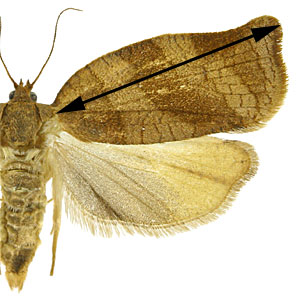 : 7.5-9.0 mm (male); 8.0-11.0 mm (female)
: 7.5-9.0 mm (male); 8.0-11.0 mm (female)
Forewing color is primarily brownish gray, with dark-brown to black markings that are more prominently expressed in the male. Hindwings are a uniform gray. Males have a forewing costal foldforewing costal fold:
a flap or fold at the base of the forewing that contains specialized sex scales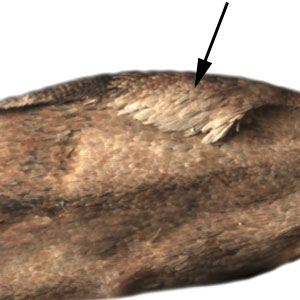 .
.
Male genitalia are characterized by a narrow uncusuncus:
a sclerotized process which is fused to the posterodorsal margin of tergum IX ; absent sociisocii:
; absent sociisocii:
a pair of lightly sclerotized setose lobes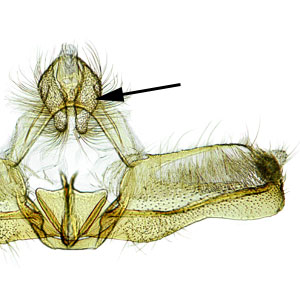 ; and broad, subtriangular valvaevalva:
; and broad, subtriangular valvaevalva:
an appendage flanking the intromittent organ that is used to clasp the female during copulation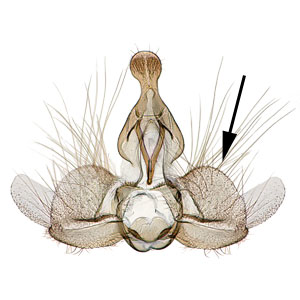 . Female genitalia are characterized by a long, narrow ductus bursaeductus bursae:
. Female genitalia are characterized by a long, narrow ductus bursaeductus bursae:
a membranous tube connecting the ostium bursae to the corpus bursae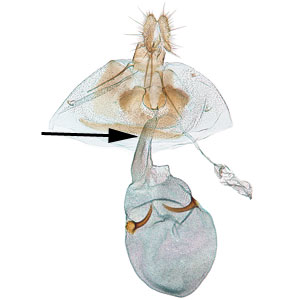 with cestumcestum:
with cestumcestum:
a long, bandlike sclerotization of the wall of the ductus bursae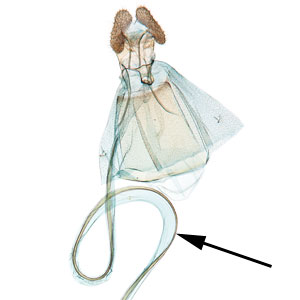 present; and short, daggar-like signumsignum:
present; and short, daggar-like signumsignum:
a sclerotized projection or patch on the interior of the corpus bursae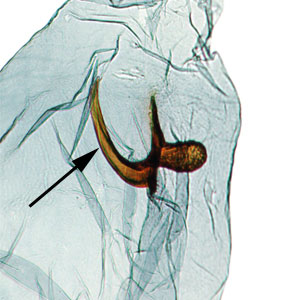 present in the corpus bursaecorpus bursae:
present in the corpus bursaecorpus bursae:
a dilated membranous sac at the anterior end of the bursa copulatrix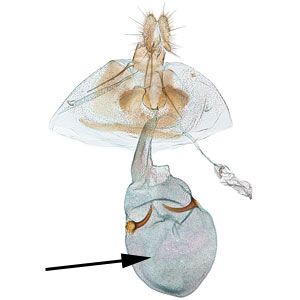 .
.
The following account is summarized from Chapman & Lienk (1971).
Larvae are 15-23 mm in length with a green abdomen. The prothoracic shieldprothoracic shield:
a sclerotized plate on the dorsal surface of the prothorax 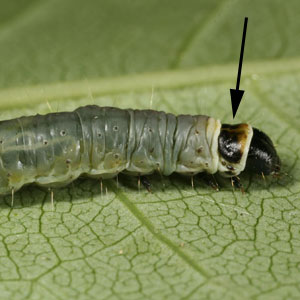 and head are uniformly black in the last instar. The prothoracic legs are brown to black while the other thoracic legs are pale green and unmarked.
and head are uniformly black in the last instar. The prothoracic legs are brown to black while the other thoracic legs are pale green and unmarked.
Adults of A. grisea are unlikely to be confused with other native Nearctic Archips. General forewing pattern is similar to some forms of Archips podana, Archips crataegana, and Archips rosana, although the grayish appearance of the forewing and hindwing should be sufficient to distinguish A. grisea from these other species.
The life cycle and larval habits of A. grisea are similar to those of Archips argyrospila, Archips mortuana, and Choristoneura rosaceana. Larvae of A. grisea are distinguished from these other species by a uniformly black prothoracic shieldprothoracic shield:
a sclerotized plate on the dorsal surface of the prothorax  . Archips cerasivorana larvae also have a uniformly black prothoracic shieldprothoracic shield:
. Archips cerasivorana larvae also have a uniformly black prothoracic shieldprothoracic shield:
a sclerotized plate on the dorsal surface of the prothorax  , but the larvae live and feed in communal nests.
, but the larvae live and feed in communal nests.
The following account is summarized from Chapman & Lienk (1971).
Archips grisea completes one generation per year. Adults are present as early as April in Texas, but are active from June to July further north. This species has the same basic life history information as Archips argyrospila and can often be found in association with A. argyrospila infestations.
Females lay eggs in masses of approximately 50-60 individual eggs on small diameter branches of the host. Eggs overwinter and first instar larvae hatch the following spring. Larvae feed on leaves and young fruit and pupation occurs within the final larval feeding site.
Host plants
Chapman and Lienk (1971) state that apple and hawthorn are the primary larval hosts in the northeastern U.S. Other host plants are listed here.
| Host plant | Host plant family | Reference(s) |
| Rudbeckia sp. | Asteraceae | Forbes 1923Forbes 1923: Forbes, W. M. T. 1923. The Lepidoptera of New York and neighboring states. Primitive forms, Microlepidoptera, Pyraloids, Bombyces. Cornell Univ. Argic. Exp. Sta., Mem. 68. 729 pp.; Freeman 1958Freeman 1958: Freeman, T. N. 1958. The Archipinae of North America (Lepidoptera: Tortricidae). Canadian Entomologist, Supplement 7 (Vol. 90): 1-89. |
| Quercus sp. | Fagaceae | Forbes 1923Forbes 1923: Forbes, W. M. T. 1923. The Lepidoptera of New York and neighboring states. Primitive forms, Microlepidoptera, Pyraloids, Bombyces. Cornell Univ. Argic. Exp. Sta., Mem. 68. 729 pp.; Freeman 1958Freeman 1958: Freeman, T. N. 1958. The Archipinae of North America (Lepidoptera: Tortricidae). Canadian Entomologist, Supplement 7 (Vol. 90): 1-89.; Wagner et al. 1995Wagner et al. 1995: Wagner, D. L., Peacock, J. W., Carter, J. L., Talley, S. E. 1995. Spring caterpillar fauna of oak and blueberry in a Virginia deciduous forest. Annals of the Entomological Society of America. 88: 416-426. |
| Carya sp. | Juglandaceae | Freeman 1958Freeman 1958: Freeman, T. N. 1958. The Archipinae of North America (Lepidoptera: Tortricidae). Canadian Entomologist, Supplement 7 (Vol. 90): 1-89. |
| Crataegus sp. | Rosaceae | Chapman & Lienk 1971 |
| Malus sp. | Rosaceae | Chapman & Lienk 1971 |
| Prunus virginiana | Rosaceae | Chapman & Lienk 1971 |
| Pyrus sp. | Rosaceae | Freeman 1958Freeman 1958: Freeman, T. N. 1958. The Archipinae of North America (Lepidoptera: Tortricidae). Canadian Entomologist, Supplement 7 (Vol. 90): 1-89. |
View full screen host table here
Archips grisea is distributed in the eastern United States, from Minnesota and Maine south to Texas and Florida. There is a record from Utah; Chapman and Lienk (1971) speculate this might have been the result of an introduction of infested plants from the East.